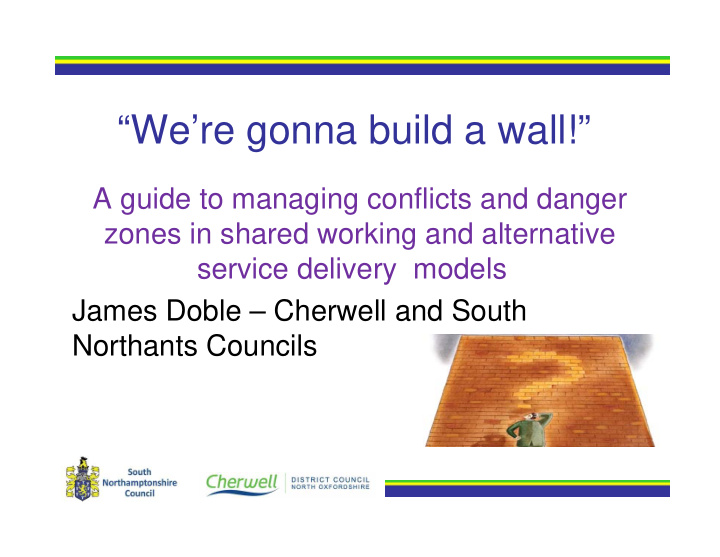



“We’re gonna build a wall!” A guide to managing conflicts and danger zones in shared working and alternative service delivery models James Doble – Cherwell and South Northants Councils
What are we talking about and why? • Shared services - two separate organisations • Council created companies are separate organisations to the councils • Two groups of members and one group of officers working for or as Directors of these different entities • A recipe for potential conflict!
What are conflicts and danger zones? • Shared officers two or more masters • Sovereign organisations • Different positions on the same issue • Conflicts of interest • Supply of goods and services • Allocation of resources • A question of loyalty • What if there is disagreement? • Funding • Planning
Some practical tips……….. • Managing expectations • How to structure a service • Managing access • Phones and Emails • Where to be seen • How to reach consensus • Us and them – who’s better? • The use of ‘We’ • How to broker a consensus • When things go wrong
What is an Ethical Wall? ‘An information barrier within an organisation erected to prevent communication that could lead to the disclosure of information which is confidential to one organisation or the other.’ Also known as Chinese wall, cone of silence, screen or firewall
Where do they exist? • Finance: investors between those who are privy to confidential information that could influence the investment decisions • Media: between journalists and advertising executives • Law firms: where different solicitors are acting for different clients on the same issue.
Examples • Cherwell and South Northants: Cherwell Local Plan • Cherwell and Graven Hill Companies: Marketing contract • Cherwell, Graven Hill and Cherwell Community Build: Affordable Housing Provision • Cherwell, South Northants and CSN Companies
What happens? • Monitoring Officer becomes aware or made aware of potential conflict • Monitoring Officer puts in place ethical wall indicating who is on ‘which side of the wall’ & communicates this to all stakeholders • People on either side of the wall should treat & behave towards each other as if they were an external organisation.
What to think about • Files and electronic correspondence: neither party should access information held by the other. • Officers should only advise members and officers on their side of the wall. • Reports to committees must be in the name of and signed off by officers on the correct side of the wall
More things to think about • Officers & members should not be present at meetings when they are dealing with the issue on the other side of the wall • Ethical wall should only be used for the issue in question and does not extend to any other areas of work.
Even more things to think about • Officers may not be able to report to their normal manager on the issue if they are on the other side • You should have and use email signatures for the organisation you are writing on behalf of and make this clear in phone calls and discussions
How long does the wall stay up? • The Ethical Wall should only be used for the issue in question and does not extend to any other areas of work. • When concluded the Monitoring Officer will take down the wall.
Recommend
More recommend